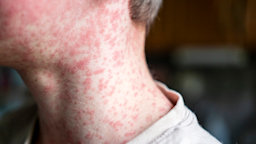Key takeaways:
COVID-19 can cause different types of skin rashes in kids and adults, but these aren’t common.
Typically, a COVID rash is similar to the rash you might get with other viral infections.
A viral rash is usually itchy and red in fair skin or purple-brown in darker skin tones. Hives and small, fluid-filled blisters can also be a feature.
A rash probably isn’t the first symptom that comes to mind when thinking of COVID-19. But in addition to a runny nose, cough, and sore throat, COVID can also cause symptoms in the skin.
In general, skin changes due to COVID aren’t very common. According to studies, about 6% of people with COVID may experience them. But it’s still helpful to know what a COVID rash looks like and what you can do about it.
What kinds of rashes are common with COVID?
There’s no single COVID rash. Like with other viral illnesses, there are many different types of rashes you can get with COVID. None of them is very common, but they can happen both in adults and children.
Search and compare options
COVID rashes can look like:
Red, purple, or brown bumps
Blisters
Itchy patches or bumps
Violet or black tiny dots or patches
Here are the main types of COVID rashes.
Morbilliform or ‘measles-like’ rash
Don’t be put off by the strange name. It just means a “measles-like” rash. Another name for this rash is a maculopapular rash. This is the most common type of rash that people get with COVID. It’s also common with other viral infections and as a reaction to some medications.
What it looks like: These are small bumps or patches that are red, purple, or brown. The color often fades with pressure.
Where it appears: The rash is usually limited to the trunk (torso, back, and abdominal areas).
What it feels like: It can be itchy.
Timing: It usually starts within the first few days of a COVID infection and can last 1 to 2 weeks.
Here’s what a morbilliform or maculopapular rash looks like in different skin tones.


COVID toes
“COVID toes” is the name given to swollen and discolored toes that happen in some people with COVID. It seems to be more common in children and young adults with COVID.
COVID-19 or cold? Here are the most common COVID symptoms — and how to tell the difference between COVID and a cold.
Top causes of rash in children: When your child gets a new rash, it can help to know the likely causes (with pictures), so you can plan your next steps.
Hives are itchy rashes that come and go. Many things can cause hives, from food to medications and even viruses. Learn about common triggers and how to treat them.
COVID toes are a type of chilblains. There are many causes of chilblains, most commonly due to exposure to cold temperatures. COVID is just one cause. Experts aren’t sure why chilblains happen with COVID. But it’s possible they happen as a result of an immune reaction to the virus that causes COVID.
What it looks like: These are small round red, purple, or brown spots that can be mottled (different colors) and swollen. Sometimes the spot turns into a blister.
Where it appears: The rash usually affects one or more toes. It can also affect the fingers.
What it feels like: It can hurt or itch.
Timing: It can develop before or after other COVID symptoms, and usually lasts for 1 to 2 weeks.
Here’s what chilblains look like. These aren’t “COVID toes” specifically, but they’re similar.


COVID hives
COVID hives (also called urticaria) are another type of rash linked to COVID. It’s likely that a COVID infection triggers a hyperactive immune reaction that causes these hives. COVID hives may be the first sign of infection.
What it looks like: Hives are smooth, raised bumps (welts) that can be red, purple, or skin-colored.
Where it appears: Hives can appear anywhere, but they’re most common on the torso, back, arms, and legs.
What it feels like: It’s very itchy.
Timing: Hives can start anytime during a COVID infection and can reappear in different locations around the body. They usually go away once COVID resolves or sooner.
Read more like this
Explore these related articles, suggested for readers like you.
Here’s what hives look like in different skin tones.


Vesicles (blisters)
Vesicles (COVID blisters) aren’t as common, but they may also be the first sign of a COVID infection.
What it looks like: The small, fluid-filled bumps look like tiny blisters.
Where it appears: It’s localized to the torso or it can spread from the torso outwards to the arms and legs.
What it feels like: It can be itchy.
When it starts: Vesicles start early in a COVID infection and usually clear within 10 days.
Vaso-occlusive lesions
This is the least common type of rash linked to COVID. That’s because it’s linked to more severe cases of COVID. It’s more likely to happen in people who are hospitalized with a COVID infection.
Vaso-occlusive skin lesions happen as a result of blockages in small blood vessels in the skin. This prevents the skin from getting enough oxygen.
What it looks like: These are purple, brown, or black patches, that are sometimes arranged in a circular pattern.
Where it appears: These lesions are more common on the torso, forearms, hands, and feet.
What it feels like: It can be painful.
Timing: This rash starts after a COVID infection and is often associated with more severe COVID symptoms (like severe pneumonia).
Less common COVID rashes
There are other rarer rashes that have been linked to COVID:
Petechiae (small dark-red or brown dots on the skin from tiny blood vessels bursting)
Livedo reticularis (a purple, net-like rash commonly seen on the legs)
Canker sores (mouth sores)
COVID rash in kids
Studies show that children can get the same types of rashes that adults get, most commonly hives or maculopapular rash. But children tend to have milder COVID infections. As a result, COVID toes (or fingers) or other rashes may be their only sign of a COVID infection. Most COVID rashes in kids usually go away on their own as their COVID infection resolves.
Multisystem inflammatory syndrome in children
In rare situations, some kids may have a more serious medical condition called multisystem inflammatory syndrome in children (MIS-C). This is a complication of COVID that usually happens 4 to 6 weeks after an active infection.
The rash in MIS-C can look different in different kids. Some may have a morbilliform rash, while others develop large patches of red or violet skin. These kids are also more likely to have lesions in or near their mouths. In addition to a rash, here are other symptoms of MIS-C to look for:
Bloodshot eyes
Pink eye
Swollen tongue
Pale, gray, or blue lips
Fever
Vomiting or diarrhea
Confusion
The risk of MIS-C has gone down since COVID vaccinations have become available.
Are there any COVID rash treatments?
Most COVID rashes go away on their own as the body fights the COVID infection. (Exceptions are the more serious rashes like vaso-occlusive lesions and rashes linked to MIS-C in children.)
But if you’re uncomfortable with rash symptoms, these at-home treatments can help:
Over-the-counter (OTC) hydrocortisone or calamine lotion to help with itching
Cold compresses to lower swelling
OTC pain relievers, like ibuprofen or acetaminophen
Oatmeal baths to soothe itchy or irritated skin
OTC antihistamines like diphenhydramine (Benadryl), loratadine (Claritin), or fexofenadine (Allegra) to help with itching
How long does a COVID rash normally last?
Most COVID rashes typically last a week or two. However, some people may experience the COVID toes rash for much longer — from weeks to months. This is most likely to happen when someone has long COVID. In this situation, the rash may last as long as the person has other COVID symptoms.
What should you do if you think you have a COVID rash?
If you have a new rash or other COVID symptoms, you can take a test to see if you have COVID or not. Remember, a COVID rash may be the only sign of COVID.
If you do have COVID, here are some steps you may want to take:
See your primary care provider for COVID treatment, if needed.
Stay home from work or school.
Avoid people with risk factors for severe COVID, like older adults or those with a weakened immune system.
Treat your COVID rash (as explained above) if it’s bothering you.
If you’re concerned about your rash, your primary care provider or a board-certified dermatologist can help make a diagnosis and suggest treatment options. Many clinicians offer virtual visits that you can set up from home.
Is a COVID rash contagious?
COVID rashes themselves aren’t contagious. But if you have COVID and a rash, you can transmit the virus to others. This is true even if you don’t have other symptoms of COVID, like a runny nose, cough, or sore throat.
Frequently asked questions
COVID rashes are more common on the arms, legs, and torso, but they can happen on the face. Some studies actually suggest that the face is the most common place for kids to get a rash. If you have a rash on your face and you’re not sure what it is, let a healthcare professional know. They can help you figure out what’s causing it.
Yes, the COVID vaccine can cause a rash in some people. These are usually mild and go away on their own. Here are some types of COVID vaccine rashes:
Injection site reaction: An injection site reaction shows up as immediate redness and swelling where you got the shot (the most common rash).
Rashes on the body: Hives (welts) or patchy red or purple spots and bumps
COVID arm: This is a red, swollen, tender rash that appears on the injection site about a week after the shot.
Sensitivity to the sun isn’t a reported side effect of COVID. But viruses affect each person differently and some may experience sun sensitivity during COVID. Whether you have COVID or not, it’s best to protect your skin from the sun with regular sunscreen use, seeking shade, and wearing sun-protective clothing.
COVID rashes are more common on the arms, legs, and torso, but they can happen on the face. Some studies actually suggest that the face is the most common place for kids to get a rash. If you have a rash on your face and you’re not sure what it is, let a healthcare professional know. They can help you figure out what’s causing it.
Yes, the COVID vaccine can cause a rash in some people. These are usually mild and go away on their own. Here are some types of COVID vaccine rashes:
Injection site reaction: An injection site reaction shows up as immediate redness and swelling where you got the shot (the most common rash).
Rashes on the body: Hives (welts) or patchy red or purple spots and bumps
COVID arm: This is a red, swollen, tender rash that appears on the injection site about a week after the shot.
Sensitivity to the sun isn’t a reported side effect of COVID. But viruses affect each person differently and some may experience sun sensitivity during COVID. Whether you have COVID or not, it’s best to protect your skin from the sun with regular sunscreen use, seeking shade, and wearing sun-protective clothing.
The bottom line
Skin rashes aren’t a common COVID symptom, but they’re possible. The most likely skin reaction to COVID infection is a viral or measles-like rash. Other rashes like hives, blisters, and even chilblains (so-called “COVID toes”) are possible. Most resolve in less than a week or two. If you have a new rash, take a COVID test. This can help you figure out the cause and what next steps to take.

Why trust our experts?



Images used with permission from VisualDx (www.visualdx.com).
References
Brahimi, N., et al. (2025). From viral infection to skin affliction: Unveiling mechanisms of cutaneous manifestations in COVID-19 and post-COVID conditions. Journal of Investigative Dermatology.
Brumfiel, C. M., et al. (2020). Dermatologic manifestations of COVID-19-associated multisystem inflammatory syndrome in children. Clinics in Dermatology.
Centers for Disease Control and Prevention. (2025). Clinical overview of multisystem inflammatory syndrome in children.
Children’s Hospital of Philadelphia. (n.d.). What parents need to know about multi-system inflammatory syndrome in children (MIS-C).
Dyall-Smith, D. (2016). Morbilliform drug reaction. DermNet.
Elyoussfi, S., et al. (2023). Skin reactions to COVID-19 vaccines. DermNet.
Jung, M., et al. (2024). Cutaneous manifestations associated with COVID-19: Summary of current knowledge. Journal of Education, Health and Sport.
Ludmann, P. (2024). COVID toes and other rashes COVID-19 may cause. American Academy of Dermatology Association.
MedlinePlus. (2025). Arm rash after COVID-19 vaccination.
Munarov, V., et al. (2024). Dermatological manifestations of COVID-19: A comprehensive review. Physician’s Journal of Medicine.
Özen, T., et al. (2023). Skin, mucosa and nail findings in hospitalized pediatric patients with Coronavirus disease-2019 (COVID-19). Anais Brasileiros de Dermatologia.
Polly, S., et al. (2022). Common skin signs of COVID-19 in adults: An update. Cleveland Clinic Journal of Medicine.
Polly, S., et al. (2023). Update in cutaneous manifestations of COVID-19: Special populations. Cleveland Clinic Journal of Medicine.
Rujimethapass, N., et al. (2024). Cutaneous manifestations of pediatric COVID-19 and multisystem inflammatory syndrome in children (MIS-C). Journal of the Medical Association of Thailand.
Seque, C. A., et al. (2022). Skin manifestations associated with COVID-19. Anais Brasileiros de Dermatologia.
















